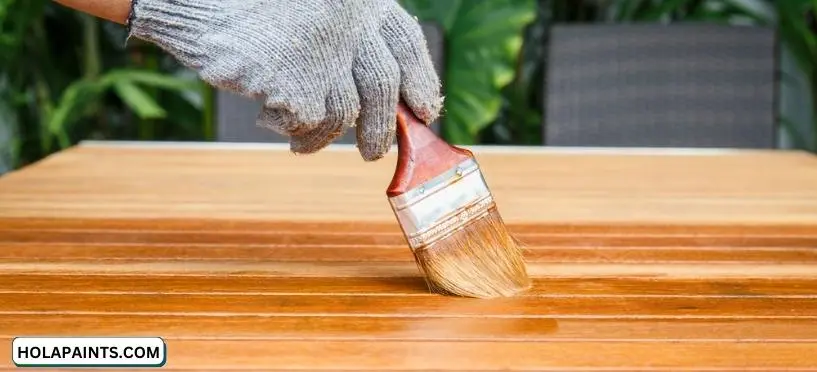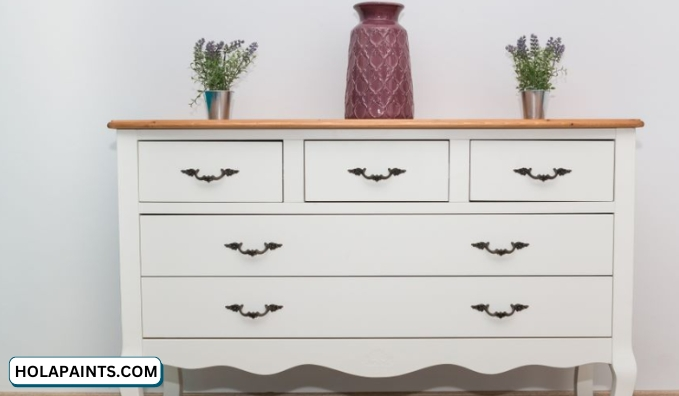Stain vs. Paint, which direction should I go? There is often confusion about which one to use or which one is better. You may be surprised to find out that the answer to that question is not as simple as you think.
When planning your project, you should choose the right finish based on what you plan to paint and what type of style you desire. Without this step, your project may not appear as you intended.
Painting vs. Staining share many similarities, but they also differ greatly which can influence your decision. In both cases, paint and stain serve as protective, preservative, and decorative materials.
Find out more about stain or paint, and then you can decide which one is best for your project.

Table of Contents
- Painting vs. Staining (Quick Summary)
- Is It Better to Stain or Paint?
- Paint:
- Stained vs Painted wood
- Best Paint Brand
- 1. Rust-Oleum Painter’s Touch Latex Paint
- 2. Sherwin-Williams Accessible Beige
- How Much Does Paint Cost?
- Pros & Cons of Painting
- Stain:
- Best Wood Stain Brands
- 1. General Finishes Oil Base Gel Stain
- 2. General Finishes Water-Based Wood Stain
- 3. SamaN Interior Water Based Wood Stain
- 4. Rust-Oleum Varathane
- How Much Does stain Cost?
- Pros & Cons of Staining
- Stain vs. Paint House: Which should you choose!
- FAQs On Staining vs Painting
Painting vs. Staining (Quick Summary)
In stain vs. paint composition, there are three basic ingredients :
If you compare a tin of stain with a tin of paint, you will notice that the stain appears thinner. The paint contains more pigment particles in the liquid vehicle, producing a noticeable difference in appearance.
The principal difference between paint and stain is that paint coats the surface and covers it, whereas stain penetrates into the surface and preserves its natural beauty.
Is It Better to Stain or Paint?
| Aspect | Stain | Paint |
| Surface Interaction | Stain permeates the material, penetrating it. | Paint forms a surface layer. |
| Primer Requirement | Stain doesn’t necessitate a primer. | Paint requires a primer before application. |
| Coating Application | Typically, stain is a single-coat application. | Paint often demands multiple coats for full coverage. |
| Surface Compatibility | Stain can be used on new or previously stained surfaces. | Applying stain to a painted surface requires paint removal. |
| Curing Time | Re-staining wood can occur relatively quickly. | Painted surfaces may need to cure before staining. |
| Color and Sheen Options | Stain provides a range of colors and sheens (clear, semi-transparent, solid, etc.). | Paint offers various colors and sheen options (flat, matte, satin, etc.). |
| Finishing Options | Stain enhances the wood’s color. | Paint can be finished with choices like lacquer, polyurethane, varnish, etc. |
| Protective Function | Stain primarily adds color and offers some moisture protection. | Paint creates a protective surface barrier. |
Paint:
Stained vs Painted wood
Best Paint Brand
1. Rust-Oleum Painter’s Touch Latex Paint
I’ve used Rust-Oleum Painter’s Touch Latex Paint, a versatile water-based option for various indoor and outdoor projects. It dries fast, offers easy cleanup, and comes in a range of colors and finishes. This durable paint sticks well, resists chipping and fading, making it ideal for furniture, walls, and more. It’s a reliable choice for achieving a pro-level finish.
For interior spaces, Carson advises opting for paints formulated for interiors with minimal or zero VOCs. Latex paint is a homeowner favorite for its easy application and cleanup, making it a top choice for kitchen and living room walls. However, for rooms exposed to moisture, such as bathrooms, Carson recommends acrylic paint.
2. Sherwin-Williams Accessible Beige
I’ve explored “Accessible Beige” from Sherwin-Williams. It’s a beloved neutral with subtle gray undertones that infuse warmth and coziness into any space. This versatile color harmonizes perfectly with earthy tones and complements both warm and cool color palettes, making it a fantastic choice for a balanced and inviting ambiance. You can find more information about it on the Sherwin-Williams paint and its cost here.
How Much Does Paint Cost?
There is an average cost of $15 to $50 per gallon of paint and each can covers about 400 square feet. A common mistake homeowners make when painting their homes is selecting the wrong paint for the project. For more details on how much it costs to paint a room, please refer to this detailed guide.
A comparison of paint prices for different types of paint is shown in this chart.
| Type Of Paint | Used For | Price per Gallon |
| High Gloss | High gloss paints are most reflective, durable and easiest to clean. It is a good choice to be used on cabinets, doors, windows, trim. | $30 – 120 |
| Flat paint | Applying this product takes less time because of its matte finish. It absorbs light, which makes it ideal for covering small imperfections. | $27 – 40 |
| Matt | Smooth, non-reflective appearance that hides nail holes and other surface blemishes. It is a go to option for drywall, bedroom, dining room. | $25 – 50 |
| Eggshell | Eggshell paint is easier to wash than flat sheen paint. It is a popular type of wall paint today. Living rooms, hallways, and dining rooms are best suited for it. | $24 – 40 |
| Satin Paint | This paint is durable and has a lustrous sheen. It is used for ceilings, walls and woodworking projects. | $29 – 42 |
| Semi-Gloss | It has a noticeable shine finish and is more durable than matte and flat paint. You can use semi-gloss finishes for toilet (bathroom), trim, kitchens, and moldings. | $33 – 56 |
Pros & Cons of Painting
PROS:
CONS:

Stain:
I’ve had firsthand experience with General Finishes Oil Base Gel Stain, and I must say, it does an exceptional job enhancing wood grain and is particularly well-suited to intricate projects such as pine. The application process is easy, but for the best outcome, it’s essential to take your time and apply up to three coats. With a selection of 15 appealing colors, it’s a top-quality choice for achieving superb finishes.
Useful Resource: Have you ever considered the gel stain over paint technique for reviving your furniture?
Best Wood Stain Brands
1. General Finishes Oil Base Gel Stain
I’ve had firsthand experience with General Finishes Oil Base Gel Stain, and I must say, it does an exceptional job enhancing wood grain and is particularly well-suited to intricate projects such as pine. The application process is easy, but for the best outcome, it’s essential to take your time and apply up to three coats. With a selection of 15 appealing colors, it’s a top-quality choice for achieving superb finishes.
2. General Finishes Water-Based Wood Stain
You can also use General Finishes Water-Based Wood Stain, and it’s an eco-friendly choice with minimal odor and low VOCs. Preparing the wood and applying it carefully leads to rich, lustrous results. It’s suitable for various interior wood projects like furniture, floors, and cabinets. You can choose from over 15 beautiful colors, and it’s easy to apply by hand or with a sprayer. Just remember not to exceed two coats to avoid uneven results, and finish with a sealant after letting it dry for two hours. This stain offers quality and versatility for indoor projects.
3. SamaN Interior Water Based Wood Stain
Other than General finishes, I have also tried SamaN water-based stain, which is perfect for indoor woodworking. It’s safe, odorless, and easy to apply without a wood conditioner. You can layer it without raising the wood grain. Plus, there are so many color options, even fun ones like raspberry and turquoise, to make your projects unique.
4. Rust-Oleum Varathane
I am in love with its quick drying formula seriously. I often used Varathane’s oil-based wood stain for interior projects, particularly for my kitchen cabinets. It’s a one-coat wonder that dries in just one hour. Applying a second coat enhances the results. However, prep work is crucial – sand the wood thoroughly. With trendy colors and classic wood tones to choose from, it’s a quick and cost-effective way to revamp cabinets. Don’t forget to protect them with a polyurethane coat.
How Much Does stain Cost?
The cost of a gallon of stain ranges from $20 to $50, and it covers an area of 175 to 300 square feet.
| Type Of Stain | What is wood stain used for | Price per Gallon |
| Solid Deck Stain | With solid stain, your deck can be protected from moisture damage caused by rain, snow, and other precipitation. It blocks ultraviolet rays and can sometimes be used over painted surfaces. | $25 – $70 |
| Water-Based Deck Stain | Water stains last longer than oil-based stains, as they have high UV resistance and color retention. It is primarily used for small indoor and outdoor projects that are environmentally friendly. | $20 – $90 |
| Oil-Based Deck Stain | Oil-based stains are ideal for furniture or large wood surfaces, as they dry more slowly, which gives the piece a more natural look and even finish. It can sometimes be applied over paint. | $35 – $120 |
| Semi-Solid Deck Stain | Semi-Solid Stains provide hiding coverage on wood surfaces. It is a good choice for older decks. | $40 – $90 |
| Semi-Transparent Deck Stain | It protects and beautifies exterior wood surfaces. In the case of weathered or stained decks, this is an excellent option. | $20 – $100 |
| Transparent Deck Stain | This stain preserves the natural color of your deck. | $20 – $60 |
| Clear Deck Stain | It provides natural look and good protection for wood surface against graying and cracking. | $20 – $50 |
Pros & Cons of Staining
PROS:
CONS:
Stain vs. Paint House: Which should you choose!
Hopefully you know all about Painting vs. Staining. They are simply 2 different finishes that deliver a different look. Each application is good in its own way. Let’s see what you think would be the best choice for your home.
FAQs On Staining vs Painting

Rosalie Sanchez
DIY enthusiast with years of experience in home decor and home improvement. With a passion for educating consumers about DIY projects. Every time, I work with our painting professionals to provide you with the best painting product reviews and how-to advice. You can follow me on Facebook.


